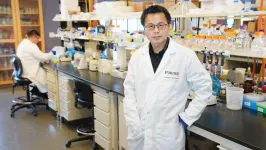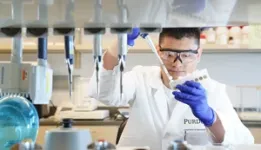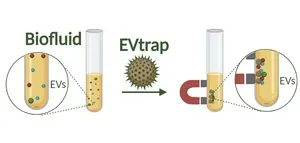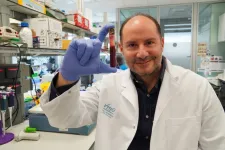(Press-News.org) New liquid biopsy method offers potential for noninvasive Parkinson’s disease testing
EVtrap technology identifies proteins from brain cells in urine samples
WEST LAFAYETTE, Ind. – A team led by researchers at Purdue University and Purdue spinoff company Tymora Analytical Operations has developed a technique that may reveal signs of Parkinson’s disease in urine samples.
The technique gives researchers a chance to see if LRRK2 (leucine-rich repeat kinase 2) proteins, which are linked to Parkinson’s disease, and their downstream pathways are altered in samples from Parkinson’s patients. The method could eventually lead to widespread noninvasive testing for other neurodegenerative conditions as well as cancer.
“We believe this is a logical and rational approach to move forward for diagnosing Parkinson’s disease,” said W. Andy Tao, professor of biochemistry at Purdue. “Diagnosis for this type of neurodegenerative disease is difficult.” Cognitive and movement testing can take a year or more to confirm the diagnosis, so molecular tests for early diagnosis and intervention can help people with Parkinson’s faster, he explained.
Tao and eight co-authors from Purdue, Tymora, The Michael J. Fox Foundation for Parkinson’s Research, and Columbia University published their findings in the Communications Medicine journal.
“It’s going to be a big new area in diagnostic development,” predicted co-author Anton Iliuk, Tymora’s president and chief technology officer, “especially for neurodegenerative diseases and cancer.”
Parkinson’s disease alone affects an estimated 1% of the over-60 population. Up to a million Americans live with the disease, while 90,000 new cases are diagnosed each year.
The paper’s co-authors include Marco Hadisurya, a doctoral student in biochemistry; Kananart Kuwaranancharoen, a doctoral student in electrical and computer engineering; Xiaofeng Wu, who received his doctorate in chemistry at Purdue in 2022; Li Li, Tymora Analytical Operations; Zheng-Chi Lee, West Lafayette Junior/Senior High School; Roy Alcalay, MD, Columbia University; and Shalini Padmanabhan from The Michael J. Fox Foundation, which funded the work.
The project began several years ago after Padmanabhan read some of Iliuk and Tao’s work on the EVtrap (Extracellular Vesicles total recovery and purification) method for urinary analysis and proposed a collaboration.
“When I reviewed the data from their previous publication,” Padmanabhan said, “it was interesting to note the expression of an important Parkinson’s disease-linked protein, LRRK2. This piqued my interest since this approach provided us with an opportunity to determine if LRRK2 proteins or the downstream pathways they impact are actually altered in urinary samples from Parkinson’s patients who harbor a mutation in the gene.”
In 2017, Tao led a team that developed a blood test that could feasibly detect breast cancer. In that work, Tao and his colleagues compared samples taken from breast cancer patients and a healthy control group.
“We identified phosphorylated proteins, which are a typical hallmark of cancers,” Tao said. And within those proteins, the team found extracellular vesicles, small packages that cells use as their molecular delivery system. The finding demonstrated that a blood sample yielding phosphoproteins could serve as a potential marker for early cancer diagnosis or for monitoring disease progression.
The team was able to rapidly isolate the vesicles from urine samples, using the EVtrap method developed by Tymora.
“We have used the method for a number of indications, primarily focusing on different cancers for biomarker discovery and validation,” said Iliuk, who received his doctorate in biochemistry at Purdue in 2011. Iliuk and Tao co-founded Tymora Analytical, which specializes in technology and services for detecting disease biomarkers in biofluids.
“This kind of analysis opens a new frontier in noninvasive diagnostics development. It’s showing that biomarkers previously thought to be undetectable have become uncovered and do a really good job of differentiating disease from non-disease state,” Iliuk said. “It’s not obvious that urine would be a source of brain-based chemicals or signatures, but it is. These EVs can penetrate the blood-brain barrier quite easily.”
After export from the brain into the bloodstream, they become concentrated or filtered into urine. But sampling such biomarkers from the brain via spinal tap is a highly invasive procedure.
“Especially for early diagnosis that is not the preferred sampling method,” Tao said. Urine samples contain proteins that could be disease markers, but many perform housekeeping functions that are unrelated to disease.
“Extracellular vesicles provide a way to focus on disease markers because they are released by certain types of cells,” he said.
Among the many ways to study the impact of LRRK2 is to track its biological pathway, which can be done by analyzing urine, blood and cerebrospinal fluid. The EVtrap method provided an easy way to track changes in urine, which is collected for many clinical studies.
The LRRK2 Biobanking Study at Columbia University has a large bank of urine samples available for meaningful Parkinson’s disease research. Columbia University co-author Alcalay, who provided many of the samples, also helped correlate EVtrap data with the clinical data. For the Communication Medicine study, the team studied samples from people with and without the LRRK2 gene mutation, and patients with and without the disease.
Padmanabhan noted, “This study also highlighted that changes in urinary proteins could serve as a proxy for changes in protein signatures that occur in brain diseases like Parkinson’s disease.”
The study follows a 2021 paper published in the journal EMBO Molecular Medicine by an international team of researchers showing a connection between LRRK2 and brain proteins in urine samples. That study, led by Matthias Mann of Germany’s Max Planck Institute of Biochemistry, included Padmanabhan and Columbia University’s Alcalay as co-authors.
Writer: Steve Koppes
END
New liquid biopsy method offers potential fornoninvasive Parkinson’s disease testing
EVtrap technology identifies proteins from brain cells in urine samples
2023-05-17
ELSE PRESS RELEASES FROM THIS DATE:
GW to co-lead a new $20 million NSF AI institute
2023-05-16
WASHINGTON (May 16, 2023) - The George Washington University is co-leading a multi-institutional effort supported by the National Science Foundation (NSF) that will develop new artificial intelligence (AI) technologies designed to promote trust and mitigate risks, while simultaneously empowering and educating the public.
The NSF Institute for Trustworthy AI in Law & Society (TRAILS) announced on May 4, 2023, unites specialists in AI and machine learning with systems engineers, social scientists, legal ...
Discrimination, crime and suicidal thoughts associated with greater odds of firearm ownership among Black adults
2023-05-16
Black adults – particularly Black women – with higher levels of education and experiences of discrimination and crime are more likely to own a firearm, according to a study by the New Jersey Gun Violence Research Center at Rutgers.
In a new study appearing in the Journal of Clinical Psychology, researchers found that Black adults who endorsed firearm ownership were more likely to grow up in homes with firearms, had previously shot a firearm and planned to acquire a firearm in the coming year.
“The higher rates of firearm ownership among highly educated Black women were somewhat surprising to us,” said Michael Anestis, executive director ...
Some young cancer survivors face higher risk of premature heart failure
2023-05-16
Mean age at diagnosis of heart failure was 32 years old
First study to estimate risk of heart failure among young adult cancer survivors treated with this category of chemotherapy
Study raises awareness for patients, clinicians to monitor for heart failure symptoms, consider strategies for prevention
CHICAGO --- Imagine surviving cancer only to learn the drug that saved your life has introduced a completely different health risk: heart failure.
A new Northwestern Medicine study has found young adult cancer survivors (between 18 and 39 years old at diagnosis) were at higher risk (2.6 times) of heart failure when treated with anthracyclines, a specific category ...
New research sheds light on how shift work may influence fertility
2023-05-16
Only four weeks of shift work-like patterns in female mice are enough to disrupt their biological clock and reduce fertility, according to research presented at the 25th European Congress of Endocrinology. The findings help scientists better understand how circadian disturbances impact female fertility, which could eventually lead to future prevention strategies for women working in non-standard work schedules.
The circadian rhythm is generated by the body’s internal clocks which are synchronised to a 24-hour period, mostly by changes in light across days. These clocks regulate various biological functions and processes, including the sleep-wake cycle, ...
Drs. Dawn Hershman and Primo Lara elected group co-chairs-elect of SWOG Cancer Research Network
2023-05-16
The board of governors of the SWOG Cancer Research Network has elected Primo N. Lara, Jr., MD, and Dawn L. Hershman, MD, MS, as group co-chairs-elect. The two will serve in that capacity until the term of the current group chair, Charles D. Blanke, MD, ends in spring 2025. They will then begin a six-year term as SWOG’s first group co-chairs.
In a joint statement, Hershman and Lara said, “We both understand that the success of SWOG has been fundamentally anchored in collaborative interdisciplinary team science. We are convinced ...
At the foot of the geologically diverse front range
2023-05-16
Boulder, Colo., USA: The Geological Society of America (GSA) is pleased to announce the upcoming 2023 GSA Rocky Mountain Section Meeting to be held from 23–25 May in Fort Collins, Colorado, USA. This highly anticipated event will provide a dynamic platform for scientists, researchers, industry professionals, and students to exchange ideas, present research findings, and foster collaborations. The meeting will feature a wide range of engaging sessions, a plenary lecture on climate intervention, scientific field trips, informative short courses, and impactful mentoring programs ...
Chan Zuckerberg Initiative funds COMBINEDBrain to fast track research for rare neurological disorders
2023-05-16
COMBINEDBrain’s Founder and Director, Dr. Terry Jo Bichell, understands the power of collaboration. In her years as a neuroscientist, advocate, and rare patient parent, she has witnessed the field of neurodevelopment transform from a broad focus on autism or intellectual disability, to an era based on rare genetic disorders. When new disorders are identified, Patient Advocacy Organizations spring up, led by passionate parents with the drive and determination to cure their children. Some of these organizations represent as many as 10,000 patients, some as few as 10. No matter their size, each organization must follow a similar path to ...
Novel ACT-Discover liquid biopsy shows 30% increased sensitivity in detecting tumor DNA in blood
2023-05-16
Liquid biopsy is increasingly stepping up as a non-invasive approach in detecting and tracking circulating tumor DNA (ctDNA) in blood and providing crucial insights into the dynamics of cancer evolution and intra-tumor heterogeneity as drivers of cancer drug resistance.
One main limitation of liquid biopsy to-date is the low sensitivity of current approaches in tumor types that do not shed enough DNA into the bloodstream, including pancreatic cancer.
Co-led by VHIO’s Rodrigo A. Toledo, a study published in Genome Medicine (1) reports on the development of a novel ctDNA-based approach, Aneuploidy in Circulating Tumor DNA ...
Rutgers researchers find flaws in using source reputation for training automatic misinformation detection algorithms
2023-05-16
Researchers at Rutgers University have found a major flaw in the way that algorithms designed to detect "fake news" evaluate the credibility of online news stories.
Most of these algorithms rely on a credibility score for the "source" of the article, rather than assessing the credibility of each individual article, the researchers said.
"It is not the case that all news articles published by sources labeled 'credible' (e.g., The New York Times) are accurate, nor is it the case that every article published by sources labeled 'noncredible' publications are 'fake news,'" ...
How government guarantees give banking customers peace of mind and keep banks open
2023-05-16
Spooked by volatile reports from the Silicon Valley Bank in early March, many customers panicked and withdrew their money, creating the largest bank failure since the 2007-2008 financial crisis. The problem — investors and customers lost confidence in the bank, proving the perception of a banks’ reliability can significantly impact its success.
Investors tend to respond negatively to volatility in firms’ performance. To mitigate investors’ concerns, when some banks receive extremely high income, they occasionally delay reporting that amount until a later date when the income ...
LAST 30 PRESS RELEASES:
Injectable breast ‘implant’ offers alternative to traditional surgeries
Neuroscientists devise formulas to measure multilingualism
New prostate cancer trial seeks to reduce toxicity without sacrificing efficacy
Geometry shapes life
A CRISPR screen reveals many previously unrecognized genes required for brain development and a new neurodevelopmental disorder
Hot flush treatment has anti-breast cancer activity, study finds
Securing AI systems against growing cybersecurity threats
Longest observation of an active solar region
Why nail-biting, procrastination and other self-sabotaging behaviors are rooted in survival instincts
Regional variations in mechanical properties of porcine leptomeninges
Artificial empathy in therapy and healthcare: advancements in interpersonal interaction technologies
Why some brains switch gears more efficiently than others
UVA’s Jundong Li wins ICDM’S 2025 Tao Li Award for data mining, machine learning
UVA’s low-power, high-performance computer power player Mircea Stan earns National Academy of Inventors fellowship
Not playing by the rules: USU researcher explores filamentous algae dynamics in rivers
Do our body clocks influence our risk of dementia?
Anthropologists offer new evidence of bipedalism in long-debated fossil discovery
Safer receipt paper from wood
Dosage-sensitive genes suggest no whole-genome duplications in ancestral angiosperm
First ancient human herpesvirus genomes document their deep history with humans
Why Some Bacteria Survive Antibiotics and How to Stop Them - New study reveals that bacteria can survive antibiotic treatment through two fundamentally different “shutdown modes”
UCLA study links scar healing to dangerous placenta condition
CHANGE-seq-BE finds off-target changes in the genome from base editors
The Journal of Nuclear Medicine Ahead-of-Print Tip Sheet: January 2, 2026
Delayed or absent first dose of measles, mumps, and rubella vaccination
Trends in US preterm birth rates by household income and race and ethnicity
Study identifies potential biomarker linked to progression and brain inflammation in multiple sclerosis
Many mothers in Norway do not show up for postnatal check-ups
Researchers want to find out why quick clay is so unstable
Superradiant spins show teamwork at the quantum scale
[Press-News.org] New liquid biopsy method offers potential fornoninvasive Parkinson’s disease testingEVtrap technology identifies proteins from brain cells in urine samples







